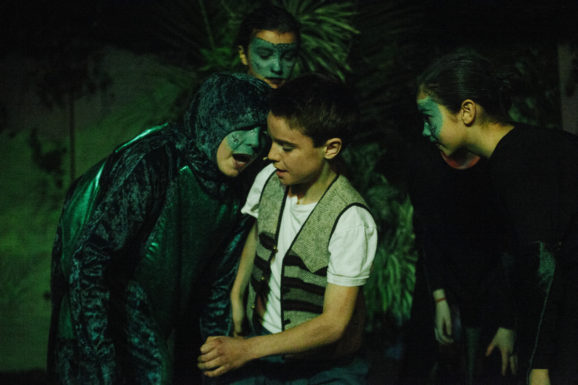In every school, there are teachers who very effectively manage students. At first, it was thought that those teachers had some big bag of tricks that other teachers didn’t have, which helped them to know just what to do in various situations. What the research is telling us is that effective classroom managers spend an inordinate amount of their time during the first few days and weeks of school establishing their expectations and procedures, in other words, their rituals. Continue Reading…
It is 8:55 a.m.—time to change classes in Washington High School. Students are relieved because they get to actually move their bodies to the next location. However, in most middle or high schools, that is probably the last time they will get to move for the next 55 minutes or until the bell rings for the next period. Continue Reading…
As rhymes are brain compatible, I wrote an original one to symbolize what we teachers and administrators do to students in schools. It is as follows:
Students can’t talk in class.
They can’t talk in the hall.
They can’t talk in the cafeteria.
They can’t talk at all!
You might think that when students are sitting quietly and looking at you, you have their undivided attention. Let me tell you something you’ve probably figured out already. Students can be looking dead in your face and not paying a bit of attention to what you are saying. Continue Reading…
Research on the brain began more than 50 years ago when Dr. Roger Sperry attempted to control seizures in epileptic patients by severing the corpus callosum, the structure that joins the left and right hemispheres of the brain. These patients appeared to function normally but would use either the left or the right hemispheres of the brain depending on what the task required. Continue Reading…
Your brain has but one purpose: to help your body survive in the real world. Notice that I wrote in the real world. In reality, the body is not confined to a wooden or metal desk 5 to 6 hours per day. Continue Reading…
Have you noticed that when you smell a particular odor, memories come flooding back? Maybe it’s a scent from your childhood that brings to mind your mother cooking one of your favorite foods in the family kitchen. Maybe it’s a fragrance that a particular person wears, and when you smell it, all of the memories of your experiences with that person are recalled. Continue Reading…
Have you ever stopped to think about how the colors in this world affect you? I didn’t think much about it until I made a mistake with color in my home. My husband and I dined with friends who had just moved into a beautiful new house. Their dining room was painted a cranberry color that provided an elegance to the already exquisite surroundings. Continue Reading…
I simply cannot teach or live without music! Neither should you. Music gets each day off to an encouraging start, leads students calmly through transition times, minimizes classroom disruptions, and gives all who hear it a sense of well-being. Continue Reading…
Patrick is constantly calling your name. Even when he knows the answers to questions, he needs your assurance that his answers are correct. You are sick and tired of reprimanding him for talking out loud without being called upon first. Continue Reading…
You may have noticed that in almost every school where students change classes, there is a group of students who will be perfectly behaved in one classroom and out of control in another. Why does this happen? It may have to do with teacher expectations. Continue Reading…
Have you ever walked down the hall in a high school and seen a teenager with his pants hanging low and a cap on his head? Have you witnessed one teacher ask the student to pull up his pants and take off the cap, and he walks by as if he has not heard the teacher’s request? Continue Reading…
Teachers ask this question of me a great deal, What is more memorable to the brain– typing on a computer or writing in long hand? Guess which one! If you said writing, you would be correct. Continue Reading…
Think back to when you finished high school. No doubt you can recall the names of many students in your senior class who did not have the grades or SAT scores to place in the top 25th or even the top 50th percentile of graduating seniors. Continue Reading…
Have you flown in an airplane recently? If so, you probably recall that the flight attendants don’t simply tell you what to do with your seat belt and the other myriad instructions they need to give. They have to show you. Why? Continue Reading…
This all-important strategy is used in at least two places in the real world – sports and medicine. Coaches advise players to picture themselves hitting the home run or scoring the touchdown before the game even begins. Continue Reading…
One of my favorite commercials is one for Walmart where a father surprises his teenage daughter with her own cell phone. In her euphoric state, she excitedly hugs her father and announces to him that she will now be able to “pin, post, tweet, snap, tag, check, and share.” Continue Reading…
There once was a man named North. His last name was America.
He fell in love with a beautiful woman named South. They got married and she took his name so she became South America. They honeymooned in Europe. Continue Reading…
I go into classrooms when requested and teach model lessons to the students. Teachers observe the lesson while I use brain-compatible strategies to provide instruction on a concept that the teacher is teaching. During one lesson in an American History class, I was asked to teach some vocabulary words that students will need to comprehend prior to their lesson labor unions. Continue Reading…
Reciprocal teaching and cooperative learning are two of the best ways to have conversations about content. In the original definition of reciprocal teaching, the process is as follows: students make predictions about a part of text to be read. Continue Reading…



















